Creating a Perennial Garden - Part 1
The vegetable garden is still pretty quiet this week, so I thought we would return to ornamental gardening and look at some of the plans for my garden and some ideas we are working on for yours. I had sent a mail a couple of weeks ago about developing the field in front of my house (Piet Oudolf style) and received a number of replies from gardeners interested in doing the same thing.
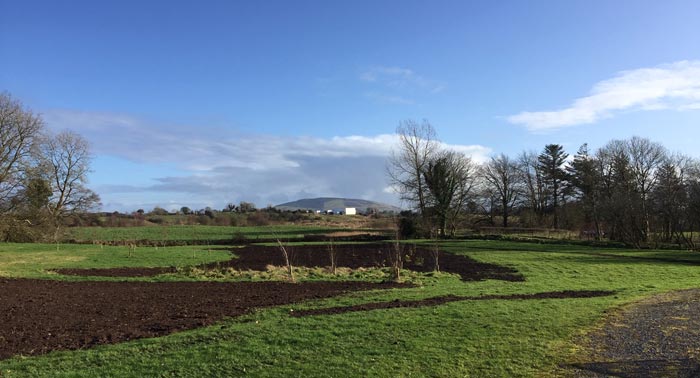
I will have some updates on all that in a few weeks and will be covering growing perennial plug plants from seed (it is such a big area I will have to produce over 2000 plants) as well as covering my choices for my soil type. This week, however, I want to look at a smaller space which is probably closer in size to many people's gardens so I am hoping it will be helpful. Also, if you don't mind, I have a couple of questions on how I can improve our seedling packs and how we can offer you the most useful planting plans.
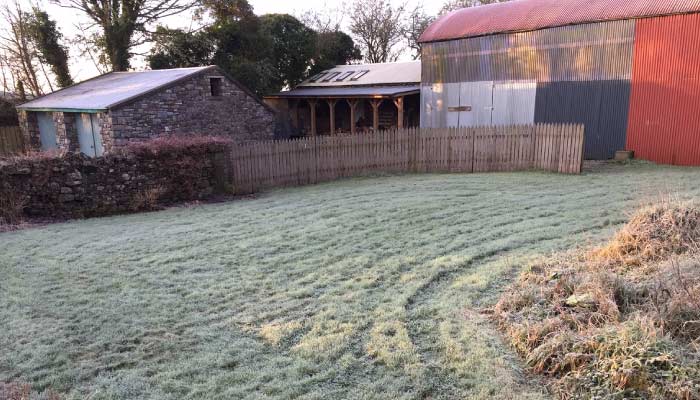
The photo above is a rather unexciting grass area at the back of my house; this year I am removing most of the lawn and replacing it with series of paths and perennial beds. The photo faces South West so the side with the buildings, wall and fence are shaded for much of the day while the spot where I am standing is generally sunny. The whole lot is sheltered as there is also a building on the other side giving me an ideal spot for a new perennial garden. The scruffy bit of grass on the right is the base of a 6ft bank so I will have 3 very different areas to deal with including shade, full sun and the dry bank. I did a scribble on the photo below with the computer mouse (like drawing with you foot after drinking a bottle of wine) to show the general gist of the plan.
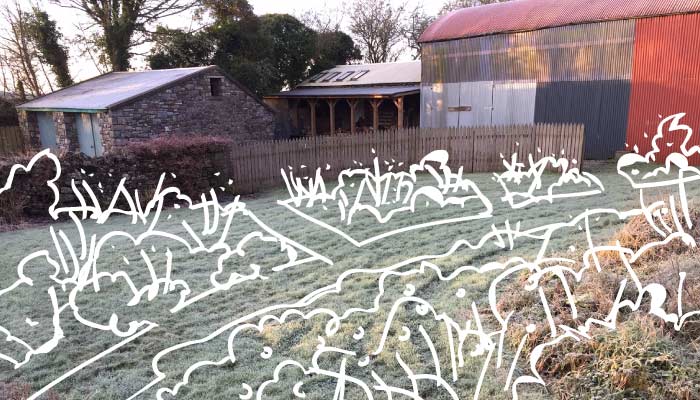
I am following the contours of the site which is sloped and curved. The central path will have a number of branches leading though the beds so I can get close to the plants and to break the area up into separate sections. The big lump of a barn in the background will be lowered in height and 'gentrified' at some stage; I will probably remove the fence at this point and let the paths lead through to the yard beyond. The beds will include a mix of grasses and perennials with plenty of colour, a long flowering period and lots of structural plant skeletons left for the winter. This natural style of planting looks beautiful but it is also one of the most useful for pollinating insects as it provides pollen and nectar and, later, a winter habitat. The spent stems and dried flower heads of summer are left in place until mid February (unless you have early bulbs coming up) to give insects a home before they are removed to make way for new growth.
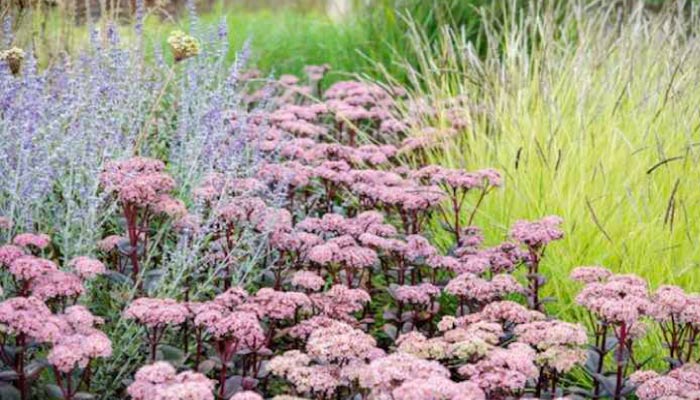
Plant shapes
I'll go into all this in more detail when I've finished the planting plan but if this is all new to you it might be worth talking about the basic plant shapes that will make up the garden. When creating a plan we need to think about how different plants work together and must take various characteristics into account including season of interest, colour, height and shape. Obviously there is an almost endless variety of plant shapes but in general I am arranging perennials in the following basic groups shown in the photos from left to right. The names aren't scientific, I am just using them to describe the flower type as they fit in the planting plan.
I'll go into all this in more detail when I've finished the planting plan but if this is all new to you it might be worth talking about the basic plant shapes that will make up the garden. When creating a plan we need to think about how different plants work together and must take various characteristics into account including season of interest, colour, height and shape. Obviously there is an almost endless variety of plant shapes but in general I am arranging perennials in the following basic groups shown in the photos from left to right. The names aren't scientific, I am just using them to describe the flower type as they fit in the planting plan.
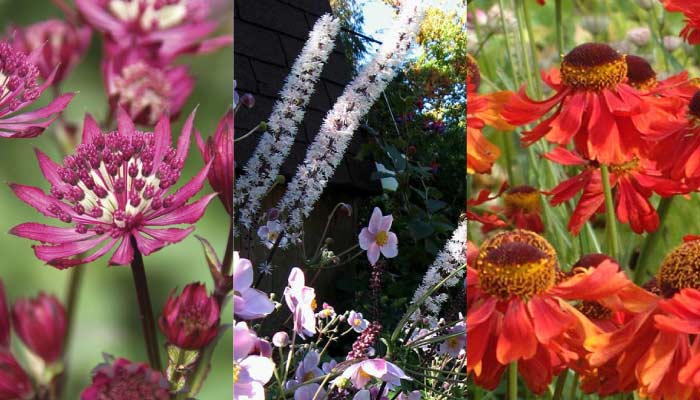
Umbellifers - You will know their vegetable cousins - carrot, celery, fennel and parsnip. Umbellifers are the dominant flower shape in our natural landscape with flowers on tall stems originating from a single main root. Tall, elegant stems give height and are see-through, while their carrot-like tap root system does not spread sideways and become invasive. All umbellifers are rich in nectar and pollen. The example in the photo is Astrantia major 'Claret'.
Spires - Most commonly seen in purple, pink or white. Spires add height and contrast to surrounding plants, with their attractive foliage reaching for the sky. This flower shape is suited to hovering insects and provides pollen over a long period as flowers open from the bottom to the top over a number of days. The white example is Actaea 'James Compton'.
Dots - Simple shaped flowers with a ring of petals surrounding a central 'button', many are related to the daisy like Aster, Rudbeckia and Echinacea and look at home bobbing among grasses as they would in a meadow. These simple, open flowers offer easy access for pollinators. The image above right is Helenium 'Moerheim Beauty'.
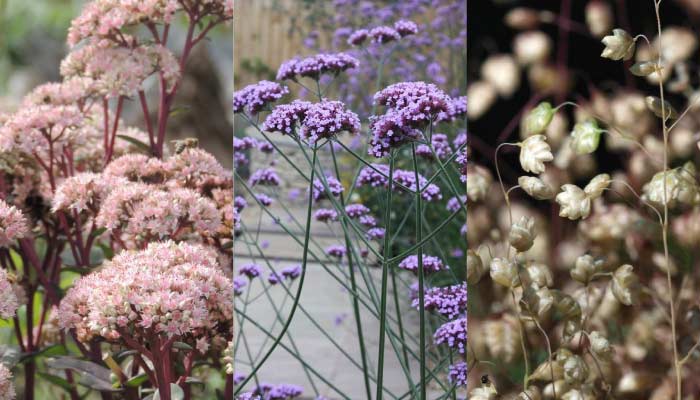
Domes - Plants that flower in layers of tight clustered blooms. While each separate flower head is tiny, they are so tightly packed and numerous that they can create bold blocks of colour. Domes also offer the ideal landing pad for insects to feast on their easily accessible nectar and pollen. An example is the easy to grow flowering plant Sedum 'Matrona' (above right).
Airheads - Not to be confused with dotty teenagers, this group contains airy, floating flowers on delicate stems that add a subtle wash of colour above other plants. They tend to flower later in the season so provide late season sustenance for pollinators. The photo is the Verbena bonariensis, a fashionable and drought tolerant herbaceous plant.
Grasses - Grasses are a key element in the New Perennial Style where they provide delicate shapes, movement and the vital muted backdrop on which the colours of other plants can sing. For effect they really need to be planted in large swathes which can weave their way through the rest of your planting. The pretty seedheads of the grass in the photo are those of Briza media.
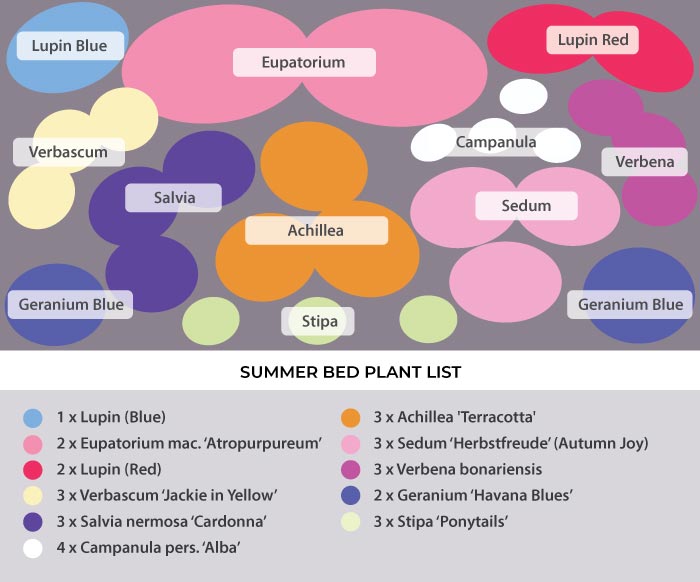
Planting plans
As you may know we dipped our toes in the perennial plants pond last year with a select range of plants chosen for their benefit to pollinators. This went very well so I am keen to keep going and improve the section further. We will be adding more varieties this growing season which will be chosen with an eye on Piet Oudolf and on the plant's benefit to wildlife. The conundrum I would really like to crack is making it easy for a beginner to plant an incredible garden so matter their level of expertise or amount of space they have available. I am thinking of creating easy to follow planting plans (with a lot of help from my friendly garden angel) that can be ordered in 6ft by 3ft blocks as in the example above.
As you may know we dipped our toes in the perennial plants pond last year with a select range of plants chosen for their benefit to pollinators. This went very well so I am keen to keep going and improve the section further. We will be adding more varieties this growing season which will be chosen with an eye on Piet Oudolf and on the plant's benefit to wildlife. The conundrum I would really like to crack is making it easy for a beginner to plant an incredible garden so matter their level of expertise or amount of space they have available. I am thinking of creating easy to follow planting plans (with a lot of help from my friendly garden angel) that can be ordered in 6ft by 3ft blocks as in the example above.
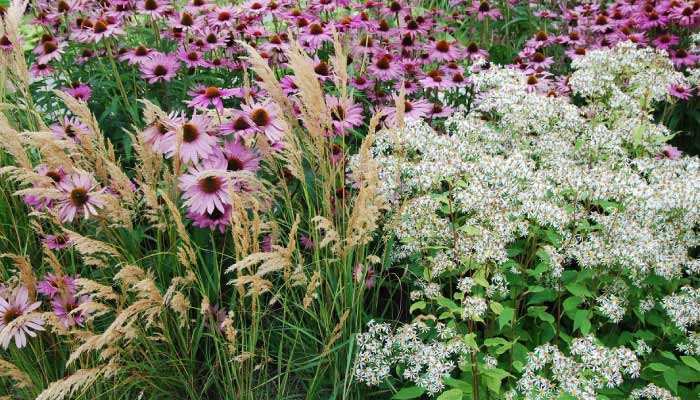
Different blocks can be mixed in a row for a more diverse planting or the same one can simply be elongated or multiplied to create a bed following the same theme. Each block can be ordered on our website and will include all the plants required and a scaled planting plan to make it easy to follow in the garden. I understand this won't cover every situation but we will have plans for sun or shade, slopes etc... so we should be able offer a solution for most sites. What do you think? If you are in the market for this type of service, what would be most helpful for you? Do you think a 'block' system will work? If you have any opinions on how I can make this idea a really useful product please comment below, I would really appreciate your feedback.
